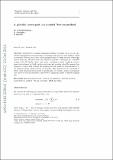| dc.contributor.author | Gurbuzbalaban, Mert | |
| dc.contributor.author | Ozdaglar, Asuman E. | |
| dc.contributor.author | Parrilo, Pablo A. | |
| dc.date.accessioned | 2016-03-01T19:29:07Z | |
| dc.date.available | 2016-03-01T19:29:07Z | |
| dc.date.issued | 2015-04 | |
| dc.date.submitted | 2014-10 | |
| dc.identifier.issn | 0025-5610 | |
| dc.identifier.issn | 1436-4646 | |
| dc.identifier.uri | http://hdl.handle.net/1721.1/101383 | |
| dc.description.abstract | Motivated by machine learning problems over large data sets and distributed optimization over networks, we develop and analyze a new method called incremental Newton method for minimizing the sum of a large number of strongly convex functions. We show that our method is globally convergent for a variable stepsize rule. We further show that under a gradient growth condition, convergence rate is linear for both variable and constant stepsize rules. By means of an example, we show that without the gradient growth condition, incremental Newton method cannot achieve linear convergence. Our analysis can be extended to study other incremental methods: in particular, we obtain a linear convergence rate result for the incremental Gauss–Newton algorithm under a variable stepsize rule. | en_US |
| dc.description.sponsorship | United States. Air Force Office of Scientific Research. Multidisciplinary University Research Initiative (FA9550-09-1-0538) | en_US |
| dc.description.sponsorship | United States. Office of Naval Research (Basic Research Challenge N000141210997) | en_US |
| dc.language.iso | en_US | |
| dc.publisher | Springer-Verlag | en_US |
| dc.relation.isversionof | http://dx.doi.org/10.1007/s10107-015-0897-y | en_US |
| dc.rights | Creative Commons Attribution-Noncommercial-Share Alike | en_US |
| dc.rights.uri | http://creativecommons.org/licenses/by-nc-sa/4.0/ | en_US |
| dc.source | arXiv | en_US |
| dc.title | A globally convergent incremental Newton method | en_US |
| dc.type | Article | en_US |
| dc.identifier.citation | Gurbuzbalaban, M., A. Ozdaglar, and P. Parrilo. “A Globally Convergent Incremental Newton Method.” Math. Program. 151, no. 1 (April 11, 2015): 283–313. | en_US |
| dc.contributor.department | Massachusetts Institute of Technology. Department of Electrical Engineering and Computer Science | en_US |
| dc.contributor.department | Massachusetts Institute of Technology. Laboratory for Information and Decision Systems | en_US |
| dc.contributor.mitauthor | Gurbuzbalaban, Mert | en_US |
| dc.contributor.mitauthor | Ozdaglar, Asuman E. | en_US |
| dc.contributor.mitauthor | Parrilo, Pablo A. | en_US |
| dc.relation.journal | Mathematical Programming | en_US |
| dc.eprint.version | Original manuscript | en_US |
| dc.type.uri | http://purl.org/eprint/type/JournalArticle | en_US |
| eprint.status | http://purl.org/eprint/status/NonPeerReviewed | en_US |
| dspace.orderedauthors | Gurbuzbalaban, M.; Ozdaglar, A.; Parrilo, P. | en_US |
| dc.identifier.orcid | https://orcid.org/0000-0002-1827-1285 | |
| dc.identifier.orcid | https://orcid.org/0000-0002-0575-2450 | |
| dc.identifier.orcid | https://orcid.org/0000-0003-1132-8477 | |
| mit.license | OPEN_ACCESS_POLICY | en_US |
